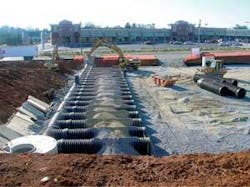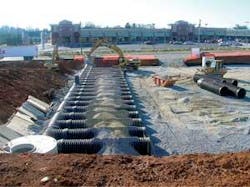Stormwater System Maximizes Valuable Retail Space
by Stephen Cooper
When remodeling the Martin's Food Store complex in Hagerstown, MD, engineers had to design a stormwater detention system that would handle the expanded site's stormwater runoff as well as that of the surrounding areas. Previously, the property utilized a surface detention pond for stormwater runoff. The new facility, however, would have six retail stores in addition to the Martin's Food anchor.
As construction of the center was being planned, the Maryland State Highway Administration (SHA) was simultaneously making plans to widen the main road. The SHA required water runoff from this expansion of Pennsylvania Avenue to travel to the shopping center's system, adding an additional burden.
“We had an existing footprint of about eight acres for the site, which included the surface detention basin,” explained David J. Habowski of J. Michael Brill & Associates (Mechanicsburg, PA), who was responsible for the site's development. “Now, we were faced with a more highly trafficked food store and other shops which would require additional parking.”
The question was how to accommodate more parking and retail space in the same area while handling increased stormwater runoff. Habowski and his team found that putting the stormwater system underground would provide the solution.
“We always want to use best management practices to maintain water quality,” Habowski said. “But, because the geotechnical report came back as karst geology — prone to sink holes — we weren't allowed to infiltrate. So we used large–diameter HDPE pipe as storage rather than an open bottom or perforated system. We're collecting all the water runoff from onsite — and from the state road out in front of our site — and conveying it into our system.”
The components specified were primarily high–density polyethylene (HDPE) pipe because Washington County does not allow the use of metal piping underground. Metal pipe can corrode while, according to the Plastics Pipe Institute (PPI), a non–profit advocacy group for the plastic piping industry, HDPE pipe is impervious to corrosion and will provide a watertight system.
Per the Channel Protection Volume (CPv) standard, Maryland requires that the first flush be handled to protect the land from excessive erosion caused by the increased flow of water. It requires that the runoff volume from a one–year frequency, 24–hour storm be captured and discharged in a controlled manner during no less than a 24–hour period.
“For the system's subsurface outlet structure, we have a 6 by 9 foot box that has a baffle and orifice at the bottom to handle the CPv,” explained Habowski. “The weir plate is cut out in the baffle to handle certain storm events, and acts as a trash rack as well.”
The HDPE pipe detention system weir plates are baffles with a ‘V' at the top, which allows water coming over the top to spill into the next area. It acts as a trap and separates oils and greases that may get into the system. These will be taken out later along with organics and trash. “This saves the owner a lot of cleanout and maintenance for the system and helps to meet EPA, state and city regulations,” said Mike Batie, P.E., CFM, technical and engineering manager for PPI.
Half of the water from the site goes directly into the underground system of 48–inch HDPE pipe sections connected by a manifold system. The other half goes through a sand filter that cleans sediment from the water then releases it into the subsurface system.
The system is rated to handle 72,428 cu. ft. of water, and has a footprint of 39,000+ square feet (243 x 162 ft.). It uses 6,200 feet of 48–inch corrugated HDPE pipe from Advanced Drainage Systems Inc. (ADS), which enables the system to handle a 100–year storm event. The system is set up on a grid pattern with the pipe in a crosshatch design. Water runoff comes in from five manholes to the manifold and into a series of 24 branches, also called laterals.
The manifold was prefabricated at the ADS plant and, because of its moderate weight, the HDPE pipe can be handled by a few people with minimal equipment. “We were able to install the pipe and concrete catch basins, tie in the branches and finish to a ready–to–pave point within a few weeks,” said Dirk Mowen, site supervisor for Kinsley Construction, who installed the system.
The new shopping center, which opened in November 2008, is one of the first in Washington County, MD, to use a subsurface structure to control stormwater runoff. “Putting the system underground provides the owners with two benefits: maximizing the land's potential and retaining the visual appeal of the center,” explained Tony Radoszewski, executive director of PPI. “An underground system also helps the environment because it can trap debris. We're finding that more and more sites are choosing underground systems because of these advantages.” uwm
About the Author:
Stephen C. Cooper is a New York–based writer reporting on the pipe industry. He can be reached at [email protected].



